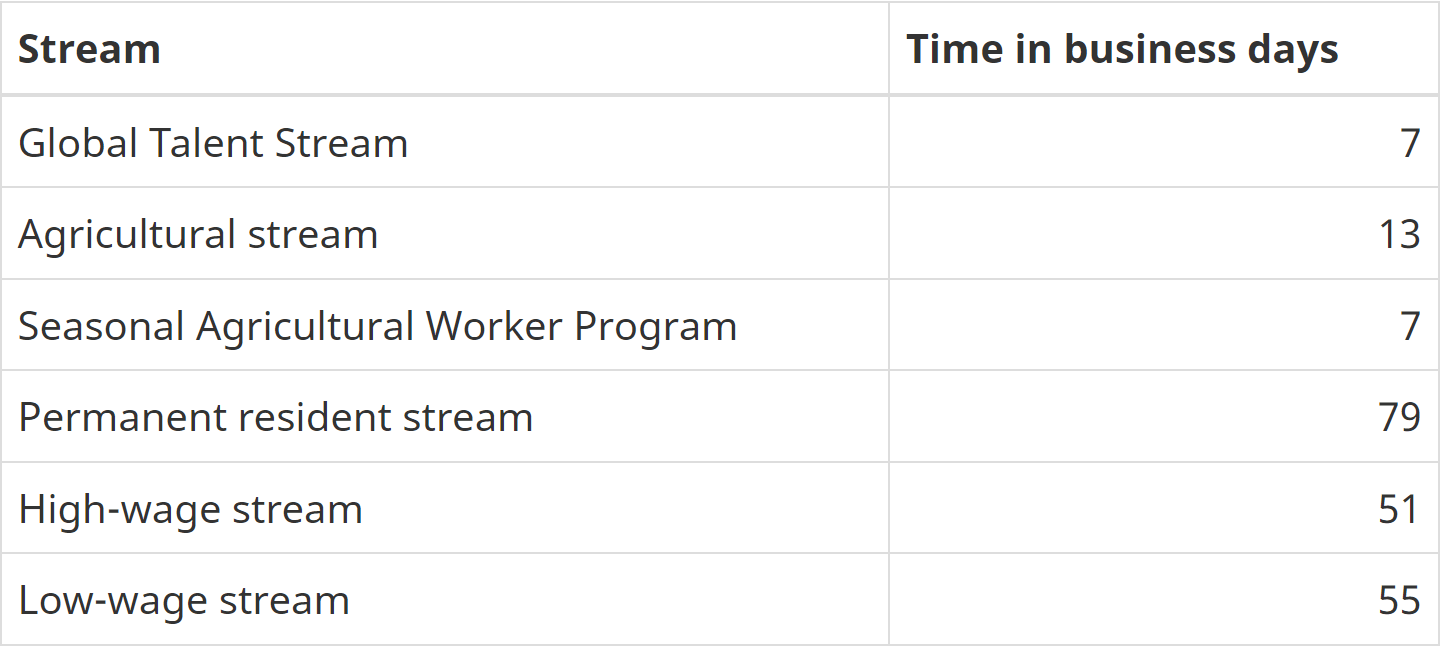Introduction
Based on the latest Immigration Levels Plan, Canada is set to welcome over 1.4 million immigrants in 2024-2026 to bolster their post-pandemic growth and increase the contribution of immigrants to varied sectors of the economy. A strong economy can be achieved by hiring specialized foreign workers which play an instrumental role in businesses and fill critical labor market gaps in their workforce.
This, however, requires an overseas immigrant worker to obtain a work permit from the Government of Canada. This is where the LMIA comes into the picture. It is a document issued following a government approval process that signifies the Canadian employer is authorized to hire foreign candidates for a specific position and location. The main objective of the LMIA is to ensure that it does not negatively impact Canadian workers and permanent residents and provides employers with access to temporary labour to fill gaps in their workforce.
What is a LMIA, and why is it needed to hire a foreign worker in Canada?
A Labour Market Impact Assessment is a document required by Canadian employers before hiring a foreign worker. This assessment aims to ascertain the impact of hiring foreign workers on the Canadian labour market.
The LMIA process is governed and regulated by Employment and Social Development Canada (ESDC) to ensure that Canadian employers do not choose foreign candidates over available Canadians and permanent residents.
An LMIA assessment can generate any one of 3 types of results: positive, negative, and neutral.
A positive or neutral LMIA decision means that hiring the foreign worker will have a positive or neutral impact on the Canadian labour market and that neither Canadian workers nor permanent residents can fill the vacant job, and employers can offer the job to foreign workers. In a negative LMIA decision, the Canadian employer is not allowed to hire a foreign national for a vacant job position as it may have a negative impact on the labour market. They will have to find a Canadian citizen or permanent resident to fill the vacancy.
Steps to hire a foreign worker with a LMIA in 2024
1. Determine whether applicants require an LMIA: Employers need to apply for LMIA to hire a foreign worker. The LMIA is not required in some situations including where foreign workers are from countries with free trade agreements with Canada or are participating in the International Experience Canada program.
2. Check the applicable prohibitions on LMIA issuance: ESDC would not process an LMIA application in some cases, may have caps on certain categories or may have refusals to process in place at different times and for different industries, for example 20% cap on the fraction of foreign workers in low-wage positions at a specific location.
3. Ascertain the wage range: The prescribed wage rate employers would pay foreign workers would be determined in this step. It must not be lower than the median wage and should be in accordance with the wages employers pay to current employees in the same job with similar experience and skills.
4. Choosing the LMIA stream: Employers must select the LMIA stream based on wage rate and occupation in comparison to the provincial median wage. Various streams are low-wage, high-wage, Global talent stream, foreign agricultural workers, and PR support.
5. Preparation of recruitment campaigns: For a successful application, employers should select advertisement methods that are in compliance with the LMIA requirements. These advertisements must be posted on the Canada Job bank website and other employment websites for at least 30 days. Employers should ensure that the campaign is relevant to the occupation advertised, track it, and create an elaborative summary of it. Depending on the stream, there are certain interest groups that must be targeted with the advertisements.
6. Submission of complete application: To avoid processing delays it is imperative that a complete LMIA application is submitted. Documents to accompany the application may include: the employer company’s financial documents, proof of ads, recruitment summary, CPA or lawyer attestation, among other supporting documents. In addition, processing fees of $1,000 CAD for each vacant position must be paid.
7. Continuance of advertising campaign: After submitting the LMIA application, a letter is issued by ESDC, including the LMIA file number. Employers are also mandated to continue advertising and reviewing applicants during the LMIA application processing by ESDC. They may be asked to provide a complete summary of recruitment data since the submission of the LMIA application at the interview.
8. Phone interview: The interview of the employer with an ESDC LMIA officer entails confirmation of LMIA application information, a discussion of the business needs, recruitment efforts and discussing the job campaign and results.
9. Receive the LMIA decision: A copy of the decision is delivered to the employer by the ESDC upon completion of processing. If a positive or neutral decision is received, it must be provided to the foreign worker so that they can attach it to their work permit application.
Ways to Apply for an LMIA
An LMIA application should be submitted by an employer in advance, at least 6 months from the prescribed date for the position. Offered wages must be compared to territorial/provincial median hourly wages by employers to determine whether their position falls under the high-wage or low-wage stream.
The 2 methods via which employers can apply for a LMIA in 2024 are as follows:
LMIA Online Portal:
1. The employer and, if applicable, third-party representative should have a valid job bank user account for verification.
2. After the creation of a job bank account, employers can fill out the job application.
Paper Application Form:
1. It includes a step-by-step checklist to complete, sign, and submit the required documentation.
2. Employers may provide the name of the foreign worker they intend to hire at the time of submission of the LMIA application.
3. It should be accompanied by processing fees except when employers are supporting foreign workers’ applications for a permanent resident visa.
What are the eligibility criteria for employees and employers for LMIA?
Stated below are some of the requirements that employers must fulfil to apply for LMIA:
- Has the financial means to pay salary to foreign workers.
- Was not involved in compliance issues in the past.
- Runs a legitimate business.
- Can demonstrate a bonafide need for a foreign worker.
- Delivers services or goods to the public.
- Did not engage in layoffs of any employees in the preceding year before applying for LMIA.
- They can finance their and their family’s stay in Canada and have adequate funds to move back to their country.
- They can convince the visa officer they have the ability to perform the job being offered.
What are the processing times for LMIAs?
At ESDC, a LMIA application is processed quite quickly. Some businesses claim to have received responses in as little as ten days. However, if ESDC is inundated with applications, it could take months to receive a response. When filling out applications, Canadian businesses should allow themselves an additional month or two. This should also be factored into the application timeline for work permits for workers. Processing times can vary depending on the number of applications received by the program, but may average 7 to 55 days depending on the LMIA steam.

What is the processing cost for LMIAs?
Families and individuals who wish to hire a foreign caregiver to assist with domestic medical requirements are exempt from paying the LMIA application processing fee. Families or individuals with an annual income of less than $150,000 who wish to hire a foreign caregiver to care for a child under 13 in their home are exempt from paying the processing fee.
To cover the cost of processing your Labor Market Impact Assessment application, the employer must pay a non-refundable fee of $1,000 per position the applicant wants.
If your application is denied, withdrawn, or cancelled, or if an adverse labour market impact assessment is made, the application processing fee is non-refundable. Only if a fee was charged in error will a refund be issued.
What are LMIA exemptions in 2024?
The International Mobility Program authorizes employers to hire temporary foreign workers without a LMIA in accordance with the section 204-208 of the Immigration and Refugee Protection Regulations (IRPR).
Companies are not required to obtain LMIA approval prior to hiring foreign workers for some short-term positions.
If your foreign worker is from a country with a free trade agreement with Canada, you probably won’t need to get a LMIA for them.
If the employees are nationals of a CUSMA (ex-NAFTA) country, such as the United States or Mexico, they are likely exempt from LMIA.
Some citizens of the European Union may be permitted to work in Canada without a LMIA from their employer in a CETA nation.
If a multinational company has a branch in Canada, it can move foreign workers from its activities overseas to Canada without getting a Labour Market Impact Assessment (LMIA) in some instances.
Employers in Quebec don’t have to advertise for the LMIA if they follow the government’s simplified process, which also speeds up the application process.
These are among some of the many LMIA exemptions available through the International Mobility Program.
What happens after LMIA is approved?
An LMIA application will be evaluated, and then the employer will be advised of the evaluation results. If a company applies for and is granted a favorable LMIA, it is within its legal rights to hire employees from other countries. In the event that the LMIA is unfavorable, the business will be unable to employ people from other countries.
Positive LMIAs have a validity period of six months after they have been administered. If the LMIA returns positive, the employer is obligated to let the foreign national know so that they can submit an application for a work visa or permanent residency.
The employer should provide a copy of this letter and Annex A to the foreign worker. The foreign worker can then submit an application for a work visa.
It is obvious that applying for a labour market impact assessment can be an onerous process. It is also very unforgiving and one mistake in advertising, NOC selection or wage discrepancy can mean starting the process all over again.
Our team of immigration experts are knowledgeable and experienced with LMIA applications and can take the hassle out of the process so employers can focus on their business operations. Our team can be contacted for LMIA support inquiries and guidance. We’re here to help you every step of the way.
Conclusion
There are six LMIA application streams that help foreign workers to apply for work permits in Canada. Each stream has different processing times and requirements.
Through the help of our consultation services, you can determine your eligibility, preferred LMIA stream, and streamlined procedure.
Applying for LMIA requires extensive documentation, and thorough examination and is a prolonged process, so employers must plan ahead and supply the relevant documents and information.
At Northern Connections Canada Immigration you can get guidance from our Regulated Canadian Immigration Professionals who will assist you in determining your eligibility, completing the LMIA applications, and ensuring that you follow government standards for lawful and ethical recruitment.
Further, we will also advise you on the required document to increase the success rate of the application.
Please contact our team for a free evaluation and expedite the processing of your LMIA application. We will be pleased to respond to your queries about the LMIA.
The Team at Northern Connections Canada



